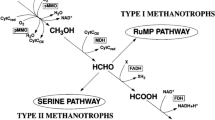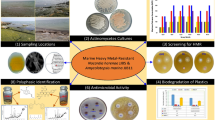Abstract
Six species of bacteria and a marine yeast which are able to use alkylated amines as a sole source of nitrogen have been isolated from marine mud and tentatively assigned to genera. One isolate (Micrococcus sp.) has been studied in greater detail. This organism has a constitutive ability to utilise trimethylamine and the lesser methylated amines as a sole source of nitrogen. Growth and metabolic studies suggest that the methylated amines are metabolized by a pathway involving a stepwise demethylation process. The implications of the results obtained on the route of regeneration and recycling of amine nitrogen in the marine environment is discussed.
Similar content being viewed by others
Literature cited
Beatty, S. A. and N. E. Gibbons: The measurement of spoilage in fish. J. biol. Bd Can. 3, 77–91 (1937).
Cantoni, G. L.: Onium compounds and their biological significance. In: Comparative biochemistry, pp 181–242, Ed. by M. Florkin and H. S. Mason. New York and London: Academic Press 1960.
Conway, E. J.: Microdiffusion and volumetric error, 4th ed. 391 pp. London: Crosby Lockwood 1957.
den Dooren de Jonge, L. E.: Bijdrage tet kennis van het mineralsatieproces. Diss. Rotterdam 1926 (quoted by M. Stephenson. Bacterial metabolism. 3rd. ed. 398 pp. London: Longman, Green & Co. 1949).
Dyer, W. J.: Amines in fish muscle. VI. Trimethylamine oxide content of fish and marine invertebrates. J. Fish. Res. Bd Can. 8, 314–324 (1952).
Hinshelwood, C. H.: Chemical kinetics of the bacterial cell, 284 pp. Oxford: Clarendon Press 1946.
Huennekens, F. M. and M. J. Osborne: Folic acid coenzymes and one-carbon metabolism. In: Advances in enzymology, pp 369–446. Ed. by F. Nord, New York: Interscience Publishers 1959.
Peel, D. and J. R. Quayle: Microbial growth on C1 compounds. I. Isolation and characterization of Pseudomonas AM I. Biochem. J. 81, 465–469 (1961).
Shewan, J. M.: The chemistry and metabolism of the nitrogenous extractives in fish. In: The biochemistry of fish. Biochemical Society Symposia No. 6., pp 28–48. Ed. by R. T. William, Cambridge: Cambridge University Press 1951.
Spencer, C. P.: Studies on the culture of a marine diatom. J. mar. biol. Ass. U.K. 33, 265–290 (1954).
Stetton, de Witt, Jr.: Biological relationships of choline, ethanolamine and related compounds. J. biol. Chem. 140, 143–152 (1941).
Vagelos, P. R., J. M. Earl and E. R. Stadman: Propionic acid metabolism. I. The purification and properties of acryl coenzyme A aminase. J. biol. Chem. 140, 143–152 (1959).
Author information
Authors and Affiliations
Additional information
Communicated by J. E. Smith, Plymouth
Rights and permissions
About this article
Cite this article
Budd, J.A., Spencer, C.P. The utilisation of alkylated amines by marine bacteria. Marine Biol. 2, 92–101 (1968). https://doi.org/10.1007/BF00351645
Accepted:
Issue Date:
DOI: https://doi.org/10.1007/BF00351645




